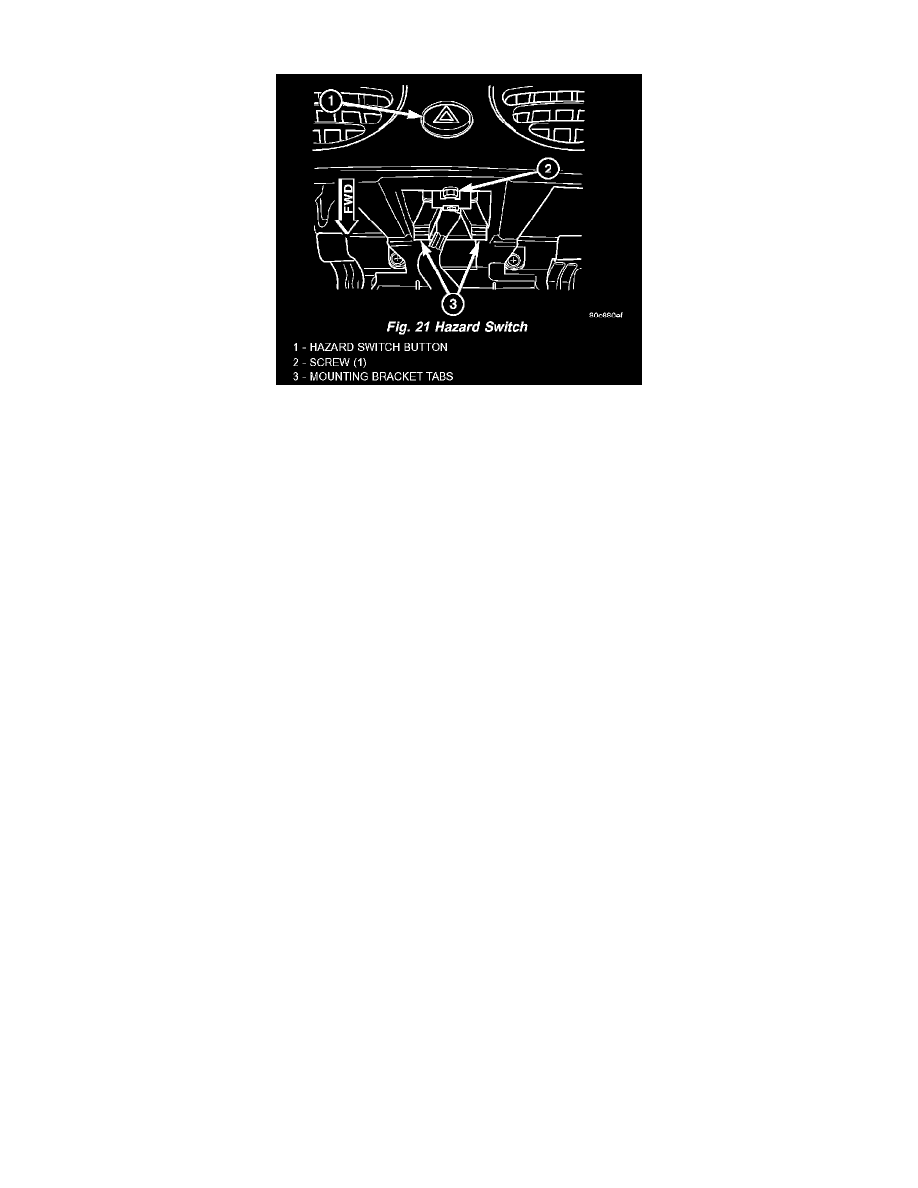Liberty Sport 2WD L4-2.4L VIN 1 (2002)

Hazard Warning Switch: Description and Operation
Fig.21 Hazard Switch
HAZARD SWITCH
The hazard switch is integral to the hazard switch module, which is secured near the center of instrument panel just above the radio. Only the
hazard switch button is visible through a dedicated, round, beveled opening on the outer surface of the instrument panel between the two center
panel outlets of the heater and air conditioning system. A red, stencil-like International Control and Display Symbol icon for "Hazard Warning"
identifies the hazard switch button. On the opposite end of the black, molded plastic hazard switch module housing from the switch button is an
integral connector receptacle and a stamped steel mounting bracket with two latch feature tabs that extend downward, while a short dowel-like
alignment pin is integral to each side of the housing just below the switch button. The switch module is connected to the vehicle electrical system
through a dedicated take out and connector of the instrument panel wire harness. Within the hazard switch module housing is the hazard switch
circuitry and an electronic circuit board with the integral combination flasher circuitry The electronic combination flasher circuitry performs both
the hazard flasher and turn signal flasher functions.
The hazard switch module cannot be adjusted or repaired and, if faulty or damaged, the unit must be replaced.
The hazard switch button is slightly recessed in the instrument panel when the switch is in the OFF position, and latches at a position that is flush
with the outer surface of the instrument panel when in the ON position. The hazard switch module produces an audible clicking sound that
emulates the sound of a conventional flasher whenever the turn signals or the hazard warning system are activated. The hazard switch module
receives battery current on a fused B(+) circuit from a fuse in the Junction Block (JB) at all times for operation of the hazard warning, and on a
fused ignition switch output (run) circuit from another fuse in the JB whenever the ignition switch is in the ON position for operation of the turn
signals. The module receives a path to ground through a splice block located in the instrument panel wire harness with an eyelet terminal
connector that is secured by a nut to a ground stud on the driver side instrument panel end bracket near the JB. Inputs to and outputs from the
hazard switch module include:
-
Panel Lamps Dimmer Input - A non-service- able incandescent bulb soldered onto the hazard switch module circuit board provides
illumination of the switch button when the exterior lighting is turned ON through an input received on the fused panel lamps dimmer switch
signal circuit. However, this bulb flashes ON and OFF at full intensity whenever the hazard switch button is in the ON position, regardless of
the status of the exterior lighting.
-
Hazard Switch Input - The combination flasher circuitry of the hazard switch module receives an internal ground input from the hazard
switch to request hazard flasher operation.
-
Multi-Function Switch Input - The combination flasher circuitry of the hazard switch module receives separate ground inputs from the turn
signal switch circuitry of the multi-function switch on right and left turn switch sense circuits to request right or left turn signal flasher
operation.
-
Body Control Module Input - The Body Control Module (BCM) can request hazard flasher operation by providing a ground path to the
combination flasher circuitry of the hazard switch module through a hazard lamp control circuit.
-
Turn Signal Output - The combination flasher circuitry within the hazard switch module responds to the flasher request inputs by energizing
and de-energizing two miniature relays on the module circuit board. These relays control the switch output through the right and left turn signal
circuits. One relay controls the right lamps, while the other controls the left.
Because of active electronic elements within the hazard switch module, it cannot be tested with conventional automotive electrical test equipment.
If the hazard switch module is believed to be faulty, replace the switch with a known good unit to confirm system operation.
